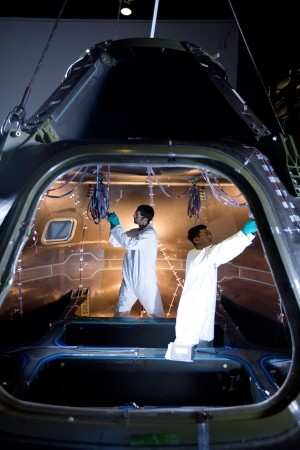Fri, Oct 16, 2009
A Crew Module Structure Made Of Composite Materials
 Alliant Techsystems said Thursday it has delivered a
technological first to NASA: a full-scale, crew module structure
made of composite materials. The Composite Crew Module (CCM) is a
unique capsule design that has the potential to reduce the overall
weight of future manned launch vehicles.
Alliant Techsystems said Thursday it has delivered a
technological first to NASA: a full-scale, crew module structure
made of composite materials. The Composite Crew Module (CCM) is a
unique capsule design that has the potential to reduce the overall
weight of future manned launch vehicles.
Composite structures reduce launch costs through weight savings
and are presently used on a variety of space launch vehicles and
aerospace structures. However, the CCM is unique in that it was
specifically designed and built to resemble a space capsule.
Full-scale structural testing will be performed at NASA's Langley
Research Center to determine the strength and viability of the
composite structure. During the destructive testing, the CCM will
be placed under load conditions similar to those observed during
launch, on-orbit, landing, and abort scenarios.
Led by the NASA Engineering and Safety Center (NESC), ATK was
part of a team of NASA and industry experts who designed and
fabricated the CCM to demonstrate how composite materials could be
used to develop a pressurized space capsule. ATK is a major
composite manufacturer and supplier for modern military and
commercial aircraft, and space launch vehicles. ATK provided
composites design, analysis, manufacturing and assembly expertise
for the CCM program.

"ATK has decades of experience in building composite structures
for launch vehicles, military aircraft, and most recently
commercial aircraft such as the Airbus A350," Jack Cronin,
President, ATK Mission Systems. "We have applied our innovative
engineering and manufacturing capabilities to help the CCM team
build a cutting-edge, composite space structure. We demonstrated
our ability to perform, partner and deliver an advanced composite
structure that's never been built for NASA."
Fabricated and assembled at ATK's Iuka, Miss. facility, the CCM
combines some of the most advanced composite manufacturing
technologies in use today. Constructed in two primary sections, the
upper and lower shells are joined together with a splice joint and
cured using out-of-autoclave technology. The bonding of the
composite assemblies and integration of metal hardware were
achieved by combining existing technology and ATK's innovative
manufacturing processes.
More News
Sikorsky UH-60 Black Hawk Helicopter Collided With An Unregistered DJI Mavic 3T Unmanned Aerial Vehicle On July 7, 2025, about 1557 central daylight time, an unregistered Sikorsky >[...]
“After considering the measures taken, minimum liquidity covenants in the Company's current debt obligations and cash flows to maintain current operational obligations requir>[...]
Ground Clutter A pattern produced on the radar scope by ground returns which may degrade other radar returns in the affected area. The effect of ground clutter is minimized by the >[...]
Aero Linx: Warbirds of America The EAA Warbirds of America, a division of the Experimental Aircraft Association in Oshkosh, Wisconsin, is a family of owners, pilots and enthusiasts>[...]
Also: Louisville UPS Crash Aftermath, Taiwan Boosts Pilot Pool, Spartan Acquires, DON’T MISS the MOSAIC Town Hall! This three-day Affordable Flying Expo brings together indoo>[...]
 NTSB Prelim: Sikorsky UH60 Sikorsky UH-60
NTSB Prelim: Sikorsky UH60 Sikorsky UH-60 Aero-News: Quote of the Day (11.13.25)
Aero-News: Quote of the Day (11.13.25) ANN's Daily Aero-Term (11.13.25): Ground Clutter
ANN's Daily Aero-Term (11.13.25): Ground Clutter ANN's Daily Aero-Linx (11.13.25)
ANN's Daily Aero-Linx (11.13.25) Airborne 11.07.25: Affordable Expo Starts!, Duffy Worries, Isaacman!
Airborne 11.07.25: Affordable Expo Starts!, Duffy Worries, Isaacman!




